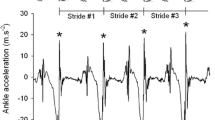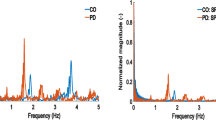Abstract
The aim of the investigation was to explore the influence of levodopa therapy on the regularity of the structural variations present in the lower extremity joints of individuals with Parkinson’s disease (PD). Ten participants with PD walked on a treadmill during the states of “off” and “on” levodopa. Approximate entropy was used to quantify the regularity of the structural variations present in the joint kinematics. Additionally, a pseudo-periodic surrogation analysis was used to evaluate if changes in the regularity of the joint’s movement were associated with a noisy or deterministic motor process. This investigation provided two key findings. The first was that the structural variations present in ankle joint were more regular with levodopa therapy. The second was that changes in the structural variations were related to a deterministic motor process. This indicated that the variations present in the walking patterns of individuals with PD most likely arose from higher-order neural couplings rather than noise in the motor process. Monitoring the regularity of the structural variations present in gait may help improve the management of PD.


Similar content being viewed by others
References
Amende, I., Kale, A., McCue, S., Glazier, S., Morgan, J. P., & Hampton, T. G. (2005). Gait dynamics in mouse models of Parkinson’s disease and Huntington’s disease. Journal of Neuroengineering and Rehabilitation, 2, 20.
Bartsch, R., Plotnik, M., Kantelhardt, J. W., Havlin, S., Giladi, N., & Hausdorff, J. M. (2007). Fluctuation and synchronization of gait intervals and gait force profiles distinguish stages of Parkinson’s disease. Physica A, 383(2), 455–465.
Fahn, S. (2005). Does levodopa slow or hasten the rate of progression of Parkinson’s disease? Journal of Neurology, 252(Suppl 4), IV37–IV42.
Fahn, S., & Elton, R. L. (1987). Unified Parkinson’s disease rating scale. In S. Fahn, C. D. Marsden, D. B. Calne & M. Goldstein (Eds.), Recent developments in Parkinson’s disease, Vol. 2 (pp. 153–164). Florham Park: Macmillan Health Care Information.
Faisal, A. A., Selen, L. P., & Wolpert, D. M. (2008). Noise in the nervous system. Nature Reviews Neuroscience, 9(4), 292–303.
Frenkel-Toledo, S., Giladi, N., Peretz, C., Herman, T., Gruendlinger, L., & Hausdorff, J. M. (2005). Treadmill walking as an external pacemaker to improve gait rhythm and stability in Parkinson’s disease. Movement Disorders, 20(9), 1109–1114.
Goldberger, A. L., Rigney, D. R., Mietus, J., Antman, E. M., & Greenwald, S. (1998). Nonlinear dynamics in sudden cardiac death syndrome heart oscillations and bifurcations. Experimentia, 44, 983–987.
Hausdorff, J. M. (2007). Gait dynamics, fractals and falls: finding meaning in the stride-to-stride fluctuations of human walking. Human Movement Science, 26(4), 555–589.
Hausdorff, J. M. (2009). Gait dynamics in Parkinson’s disease: common and distinct behavior among stride length, gait variability, and fractal-like scaling. Chaos, 19(2), 026113.
Hausdorff, J. M., Lertratanakul, A., Cudkowicz, M. E., Peterson, A. L., Kaliton, D., & Goldberger, A. L. (2000). Dynamic markers of altered gait rhythm in amyotrophic lateral sclerosis. Journal of Applied Physiology, 88(6), 2045–2053.
Hoehn, M. M., & Yahr, M. D. (1967). Parkinsonism: onset, progression and mortality. Neurology, 17(5), 427–442.
Kaplan, D. T., Furman, M. I., Pincus, S. M., Ryan, S. M., Lipsitz, L. A., & Goldberger, A. L. (1991). Aging and the complexity of cardiovascular dynamics. Biophysical Journal, 59(4), 945–949.
Kurz, M. J., Pothakos, K., Jamaluddin, S., Scott-Pandorf, M., Arellano, C., & Lau, Y. S. (2007). A chronic mouse model of Parkinson’s disease has a reduced gait pattern certainty. Neuroscience Letters, 429(1), 39–42.
Lehnerts, K., & Elger, C. E. (1998). Can epileptic seizures be predicted? Evidence from nonlinear time series analysis of brain electrical activity. Physical Review Letters, 80, 5019–5022.
Lipsitz, L. A., & Goldberger, A. L. (1992). Loss of ‘complexity’ and aging. Potential applications of fractals and chaos theory to senescence. Jama, 267(13), 1806–1809.
Maschke, M., Gomez, C. M., Tuite, P. J., & Konczak, J. (2003). Dysfunction of the basal ganglia, but not the cerebellum, impairs kinaesthesia. Brain, 126(Pt 10), 2312–2322.
Mees, A. I., & Judd, K. (1993). Dangers of geometric filtering. Physicia D Nonlinear Phenomena, 68, 427–436.
Miller, D. J., Stergiou, N., & Kurz, M. J. (2006). An improved surrogate method for detecting the presence of chaos in gait. Journal of Biomechanics, 39(15), 2873–2876.
Miyasaki, J. M., Martin, W., Suchowersky, O., Weiner, W. J., & Lang, A. E. (2002). Practice parameter: initiation of treatment for Parkinson’s disease: an evidence-based review: report of the Quality Standards Subcommittee of the American Academy of Neurology. Neurology, 58(1), 11–17.
Moore, S. T., MacDougall, H. G., Gracies, J. M., & Ondo, W. G. (2008). Locomotor response to levodopa in fluctuating Parkinson’s disease. Experimental Brain Research, 184(4), 469–478.
Morris, M. E., McGinley, J., Huxham, F., Collier, J., & Iansek, R. (1999). Constraints on the kinetic, kinematic and spatotemporal paramters of gait in Parkinson’s disease. Human Movement Science, 18, 461–483.
Pikkujamsa, S. M., Makikallio, T. H., Sourander, L. B., Raiha, I. J., Puukka, P., Skytta, J., et al. (1999). Cardiac interbeat interval dynamics from childhood to senescence: comparison of conventional and new measures based on fractals and chaos theory. Circulation, 100(4), 393–399.
Pincus, S. M. (1991). Approximate entropy as a measure of system complexity. Proceedings of the National Academy of Sciences of the United States of America, 88(6), 2297–2301.
Pothakos, K., Kurz, M. J., & Lau, Y. S. (2009). Restorative effect of endurance exercise on behavioral deficits in the chronic mouse model of Parkinson’s disease with severe neurodegeneration. BMC Neuroscience, 10(1), 6.
Riley, M. A., & Turvey, M. T. (2002). Variability of determinism in motor behavior. Journal of Motor Behavior, 34(2), 99–125.
Schaafsma, J. D., Giladi, N., Balash, Y., Bartels, A. L., Gurevich, T., & Hausdorff, J. M. (2003). Gait dynamics in Parkinson’s disease: relationship to Parkinsonian features, falls and response to levodopa. Journal of the Neurological Sciences, 212(1–2), 47–53.
Schmit, J. M., Riley, M. A., Dalvi, A., Sahay, A., Shear, P. K., Shockley, K. D., et al. (2006). Deterministic center of pressure patterns characterize postural instability in Parkinson’s disease. Experimental Brain Research, 168(3), 357–367.
Small, M., & Tse, C. (2002). Applying the method of surrogate data to cyclic time series. Physica D, 164, 187–201.
Stergiou, N. (2004). Innovative analysis of human movement. Champaign: Human Kinetics.
Vaillancourt, D. E., & Newell, K. M. (2000). The dynamics of resting and postural tremor in Parkinson’s disease. Clinical Neurophysiology, 111(11), 2046–2056.
Vaillancourt, D. E., & Newell, K. M. (2002). Changing complexity in human behavior and physiology through aging and disease. Neurobiol Aging, 23(1), 1–11.
Vaillancourt, D. E., & Newell, K. M. (2003). Aging and the time and frequency structure of force output variability. Journal of Applied Physiology, 94(3), 903–912.
Vaillancourt, D. E., Slifkin, A. B., & Newell, K. M. (2002). Inter-digit individuation and force variability in the precision grip of young, elderly, and Parkinson’s disease participants. Motor Control, 6(2), 113–128.
Acknowledgements
We would like to thank Chris Arellano, Charles Layne and Amir Pourmoghaddam for their assistance with the data collections.
Author information
Authors and Affiliations
Corresponding author
Additional information
Action Editor: K. Sigvardt
Rights and permissions
About this article
Cite this article
Kurz, M.J., Hou, J.G. Levodopa influences the regularity of the ankle joint kinematics in individuals with Parkinson’s disease. J Comput Neurosci 28, 131–136 (2010). https://doi.org/10.1007/s10827-009-0192-0
Received:
Revised:
Accepted:
Published:
Issue Date:
DOI: https://doi.org/10.1007/s10827-009-0192-0




